A recent study from SEMrush found that many marketers are not using data across their businesses effectively, despite companies’ marketing data strategies.
One of the most significant finds from the research, which was conducted by Forrester Consulting in August, was that search engine optimisation (SEO) data is used in barely more than 50% of businesses’ marketing campaigns. This is made even shocking by the fact that 90% of marketers would rank SEO in their top three marketing channels.
Other discoveries include the trend for pay per click (PPC) and SEO data to only across wider marketing teams less than half of the time – this is despite the data being considered integral to decision making.
According to the report, isolating – or ‘siloing’ – data has a limiting effect on ‘the impact of marketing efforts by preventing companies from building a more comprehensive profile of their customer’.
If marketers are to maximise the opportunities across marketing channels both on and offline, it’s absolutely critical that data and insight is shared.
Branding and Cross-Channel Marketing
The colours, images, fonts and messages should be consistent with your brand across all channels, of course, but there could be subtle differences in message variations, or images which are being split tested in Google Ads Display campaign banners. This process often identifies a clear winner for response within a specific demographic.
Data Sharing Across PPC Campaigns
If the results of your Google Ads split testing are not shared with the team running your social media PPC campaigns, such as Facebook Ads, those lessons have to be learned all over again, costing budget on clicks but also the opportunity of lost clicks and sales whilst those same lessons are learned.
The same principle can be applied to offline marketing – print ads targeting a similar demographic can be created using the results of the split test in either Google Display Ads or the results of a Facebook Ads campaign.
The best selling products from a Google Shopping campaign, again for specific demographic audiences, could and should be used to influence which products are featured more heavily in print advertising, online banners and social media ads. They could easily be justified for use with radio or TV campaigns too if you’re pursuing those avenues of advertising.
Cross-Channel Marketing = Collaboration
This lack of joined-up thinking is all too common, particularly where multiple agencies are working on a common client, or in-house teams complete part of the marketing mix but outsource others.
When teams collaborate and have strong leadership and direction, the sharing of information helps delivery significantly better results much more quickly.
There’s a further example of this which we sadly also encounter far too frequently – access to Google Analytics or Facebook Analytics data. In our experience of hundreds of digital marketing projects, there have been a handful of occasions where we weren’t permitted access to Google Analytics, or to strategies and targeting on other channels – that made it impossible to deliver the type of results we’re accustomed to.
With SEMrush’s Olga Andrienko encouraging businesses who take a ‘more pragmatic approach to data sharing and analysis’, here are our data sharing best practices to help you reap the rewards of unified marketing:
Tips for Sharing Data Across Channels
- Someone take the lead: there should be a single person who is responsible for the overall direction and coordination of marketing efforts and each of the channels.
- Have a regular huddle: this needn’t be weekly or even monthly – even a quarterly informal huddle to share some results with people working on other channels could provide some unknown insight or identify some holes in their strategy.
- Allow everyone access to Google Analytics, Facebook Analytics and any other data from Google Ads, Twitter Ads and other systems containing performance data. They don’t necessarily need admin access – most systems have a ‘view only’ access level if you’re feeling cautious about giving control to too many people.
- Analyse Multi-Channel Funnel data and the Attribution Modelling reports in Google Analytics to better understand how the different channel contribute to the sales funnel.







